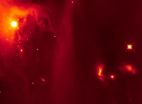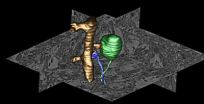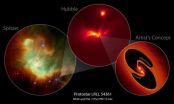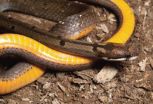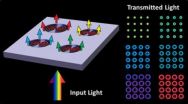(Press-News.org) The cause of the fireworks seen in this Hubble image and video is hidden behind a dense disc and envelope of dust. However, astronomers think that the strobe effect is due to periodic interactions between two newly-formed stars that are gravitationally bound to each other.
These two stars drag material inwards from a surrounding disc of gas and dust. Astronomers propose that the light flashes seen in this video are due to this material suddenly being dumped onto the growing stars as they near one another in their orbits, unleashing a blast of radiation.
"The protostar has such large brightness variations with a precise period that it is very difficult to explain," says James Muzerolle of the Space Telescope Science Institute in Baltimore, USA, who has recently studied this fascinating object using Hubble and NASA's Spitzer Space Telescope. Spitzer made repeated observations over seven years, before Hubble was pointed towards the object to make detailed observations over the period of one pulse event.
The Hubble observations uncover a spectacular movement of light away from the centre of the system, an optical illusion known as a light echo. While it might look like eruptions of gas are coming out of the protostar, these pulses are actually flashes of light propagating through the surrounding dust and gas and reflecting towards the observer: there is no substantial physical motion within the cloud over these timescales.
Flashing double star systems like this one are rare, because close binaries account for only a few percent of our galaxy's stellar population. Moreover, the pulsing light is likely to be a brief phenomenon in the early life of a star.
INFORMATION:
Notes
The Hubble Space Telescope is a project of international cooperation between ESA and NASA.
Image credit: NASA, ESA, J. Muzerolle (STScI)
Links
* Images of Hubble: http://www.spacetelescope.org/images/archive/category/spacecraft/
* A press release from NASA, with more information about scientific research into LRLL 54361 is available here: http://hubblesite.org/news/2013/04
Contacts
Oli Usher
Hubble/ESA
Garching, Germany
Tel: +49-89-3200-6855
Email: ousher@eso.org
James Muzerolle
Space Telescope Science Institute
Baltimore, USA
Tel: +1-410-338-4719
Email: muzerol@stsci.edu
Ray Villard
Space Telescope Science Institute
Baltimore, USA
Tel: +1-410-338-4514
Email: villard@stsci.edu
Hubble captures strobe flashes from a young star
2013-02-08
ELSE PRESS RELEASES FROM THIS DATE:
Hastings Center resources chart progress in debate over medical research with animals
2013-02-08
The scientific and ethical debate over the use of animals in medical research has raged for years, but perspectives are shifting, viewpoints are becoming more nuanced, and new initiatives are seeking alternatives to animal testing, according to a special report by The Hastings Center, "Animal Research Ethics: Evolving Views and Practices." The report is available on a new Web site, animalresearch.thehastingscenter.org, a hub of educational information that defines and interprets this changing landscape.
These resources are the outcome of a project on the ethics of medical ...
Excess protein linked to development of Parkinson's disease
2013-02-08
Researchers at the University of California, San Diego School of Medicine say overexpression of a protein called alpha-synuclein appears to disrupt vital recycling processes in neurons, starting with the terminal extensions of neurons and working its way back to the cells' center, with the potential consequence of progressive degeneration and eventual cell death.
The findings, published in the February 6, 2013 issue of the Journal of Neuroscience, have major implications for more fully understanding the causes and mechanisms of Parkinson's disease (PD), a neurodegenerative ...
NASA telescopes discover strobe-like flashes in a suspected binary protostar
2013-02-08
VIDEO:
This video, created from a sequence of images from the Hubble Space Telescope, shows a pulse of light emanating from the protostellar object LRLL 54361. Most if not all of...
Click here for more information.
Two of NASA's great observatories, the Spitzer and Hubble space telescopes, have teamed up to uncover a mysterious infant star that behaves like a strobe light.
Every 25.34 days, the object, designated LRLL 54361, unleashes a burst of light. Although a similar ...
The amazing amphibians and reptiles of the Philippine island Luzon
2013-02-08
A recent study of the amphibians and reptiles of Sierra Madre Mountain Range, northeastern Luzon, reveals a preliminary enumeration of more than 100 species that contribute to the unique biodiversity of the region. At present, the Luzon region's herpetological range stands at more than 150 species. Out of these, a total of 49 amphibian species have been documented, 44 of which are native and a remarkable 32 endemic. In the world of reptiles, Luzon can boast with 106 native species, 76 of which are unique to this region.
The catalogue published in the open access journal ...
Colon cancer exhibits a corresponding epigenetic pattern in mice and humans
2013-02-08
Tumourigenesis is driven by genetic alterations and by changes in the epigenome, for instance by the addition of methyl groups to cytosine bases in the DNA. A deeper understanding of the interaction between the genetic and epigenetic mechanisms is critical for the selection of tumour biomarkers and for the future development of therapies. Human tumour specimens and cell lines however contain a plethora of genetic and epigenetic changes, which complicate data analysis. In contrast, certain mouse tumour models contain only a single genetic mutation and allow the analysis ...
Study identifies liver gene that regulates cholesterol and fat blood levels
2013-02-08
Researchers have identified a microRNA liver gene, miR-27b, which regulates lipid (cholesterol or fat) levels in the blood. This regulator gene controls multiple genes involved in dyslipidemia—abnormal blood cholesterol levels that can contribute to heart disease. Study details published in the February issue of Hepatology, a journal of the American Association for the Study of Liver Diseases (AASLD), describe a new in silico approach to identify the significance of microRNAs in regulating disease-related gene pathways.
The Human Genome Project (HGP) was completed in ...
Boston College researchers' unique nanostructure produces novel 'plasmonic halos'
2013-02-08
CHESTNUT HILL, MA (February 7, 2013) – Using the geometric and material properties of a unique nanostructure, Boston College researchers have uncovered a novel photonic effect where surface plasmons interact with light to form "plasmonic halos" of selectable output color. The findings appear in the journal Nano Letters.
The novel nanostructure proved capable of manipulating electron waves known as surface plasmon polaritons, or SPPs, which were discovered in the 1950s but of late have garnered the attention of scientists for their potential applications in fields that ...
Specific warning signs of complications in colorectal surgical patients released
2013-02-08
Chicago (February 7, 2013): Colorectal surgical patients are often discharged from the hospital with vague guidance on how to recognize complications, but researchers at the Michael DeBakey Veterans Administration (VA) Medical Center and Baylor College of Medicine, Houston, aim to change that scenario. A health services research team convened a panel of surgical experts to develop a list of postoperative complication signs that should prompt colorectal surgical patients to call their surgeons or go to an emergency room. The study on the development of this early patient-centered ...
Dickkopf makes fountain of youth in the brain run dry
2013-02-08
The hippocampus – a structure of the brain whose shape resembles that of a seahorse – is also called the "gateway" to memory. This is where information is stored and retrieved. Its performance relies on new neurons being continually formed in the hippocampus over the entire lifetime. "However, in old age, production of new neurons dramatically decreases. This is considered to be among the causes of declining memory and learning ability", Prof. Dr. Ana Martin-Villalba, a neuroscientist, explains.
Martin-Villalba, who heads a research department at the German Cancer Research ...
Scientists find key to growth of 'bad' bacteria in inflammatory bowel disease
2013-02-08
(SACRAMENTO, Calif.) — Scientists have long puzzled over why "bad" bacteria such as E. coli can thrive in the guts of those with inflammatory bowel disease (IBD), causing serious diarrhea. Now UC Davis researchers have discovered the answer—one that may be the first step toward finding new and better treatments for IBD.
The researchers discovered a biological mechanism by which harmful bacteria grow, edge out beneficial bacteria and damage the gut in IBD. This new understanding, published in the Feb. 8 issue of Science, may help researchers develop new treatments for ...
